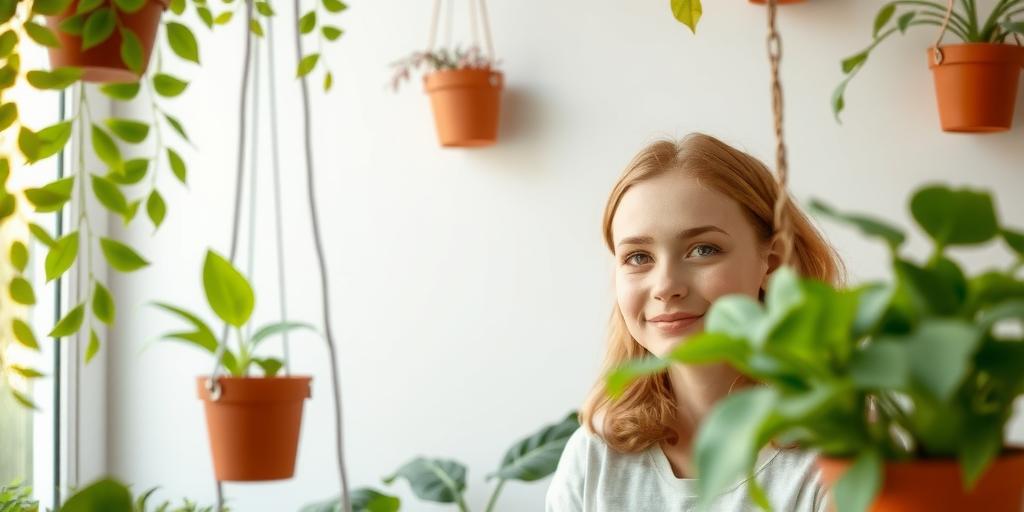
Top Non-Toxic Low Light Hanging Plants Safe for Kids and Pets
Discover the best non-toxic, low-light hanging plants perfect for homes with kids and pets! Learn which plants are safe, easy to care for, and thrive in dim spaces.
Introduction
Did you know that some common houseplants can be harmful to curious pets and little ones? If you’re looking to add greenery to your home without the worry, you’re in the right place! Low-light hanging plants are a fantastic way to bring nature indoors—especially in spaces with limited sunlight. In this guide, we’ll explore the safest, most pet- and kid-friendly hanging plants that thrive in low light. Whether you’re a busy parent or a pet owner, these plants will keep your home lush and worry-free!
Why Choose Non-Toxic, Low Light Hanging Plants?
Benefits of Non-Toxic Plants for Households with Kids and Pets
If you have curious kids or pets who love to explore, non-toxic plants are a must. Many common houseplants can be harmful if ingested, causing anything from mild stomach upset to severe poisoning. Choosing non-toxic varieties ensures that even if your little ones (or furry friends) take a nibble, they’ll stay safe. Plus, it gives you peace of mind knowing your home is filled with greenery that won’t pose a risk.
Advantages of Low-Light Plants for Homes with Limited Sunlight
Not every home is blessed with bright, sunny windows. If your space lacks natural light, low-light plants are the perfect solution. These varieties thrive in indirect or even artificial light, making them ideal for rooms with north-facing windows or dim corners. They’re also forgiving if you forget to rotate them for even sun exposure—making them great for beginners or busy plant parents.
How Hanging Plants Save Space and Improve Air Quality
Hanging plants are a game-changer for small spaces. Instead of taking up precious floor or shelf space, they add greenery vertically, making rooms feel more open. Plus, many hanging plants are excellent air purifiers, removing toxins like formaldehyde and benzene from the air. This means you’re not just decorating—you’re also boosting indoor air quality naturally.
Best Non-Toxic Low Light Hanging Plants for Kids and Pets
Spider Plant (Chlorophytum comosum) – Hardy, Air-Purifying, and Safe for Pets
Spider plants are practically indestructible, making them perfect for forgetful waterers. They thrive in low to medium light and produce cascading baby spiderettes that look adorable in hanging baskets. Best of all, they’re completely safe for pets and kids, and they’re known for their air-purifying qualities.
Boston Fern (Nephrolepis exaltata) – Lush Foliage, Thrives in Humidity
If you love a full, feathery look, the Boston fern is a fantastic choice. It prefers indirect light and a humid environment, making it great for bathrooms or kitchens. While it needs consistent moisture, its non-toxic nature makes it a safe pick for homes with pets.
Peperomia (Peperomia spp.) – Compact, Colorful, and Pet-Safe
Peperomias come in a variety of leaf shapes and colors, from deep greens to variegated patterns. They’re small, low-maintenance, and thrive in low light. Since they’re non-toxic, they’re a great option if you want a pop of color without worrying about pet safety.
Parlor Palm (Chamaedorea elegans) – Elegant and Low-Maintenance
The parlor palm adds a touch of tropical elegance to any room. It grows well in low light and only needs occasional watering. Its graceful fronds are safe for pets, making it a stylish and worry-free addition to your home.
String of Hearts (Ceropegia woodii) – Delicate Trailing Vines, Safe for Pets
This charming plant features long, trailing vines with heart-shaped leaves. It does well in bright, indirect light but can tolerate lower light conditions. While it’s drought-tolerant, its delicate appearance makes it a favorite for boho or minimalist decor—and it’s completely pet-friendly.
How to Care for Low Light Hanging Plants
Watering Tips to Prevent Over- or Under-Watering
Overwatering is one of the biggest killers of houseplants. For most low-light hanging plants, let the top inch of soil dry out before watering again. Stick your finger in the soil—if it feels dry, it’s time to water. If it’s still damp, wait a few more days. Using pots with drainage holes helps prevent root rot.
Best Soil Types for Healthy Growth
A well-draining potting mix is key. Look for blends with perlite or orchid bark to improve aeration. For ferns and other moisture-loving plants, a peat-based mix helps retain water without becoming soggy.
Ideal Placement for Optimal Light Exposure
Even low-light plants need some light. Place them near north or east-facing windows where they’ll get gentle, indirect sunlight. Avoid dark corners entirely—if a room is too dim, consider supplementing with a grow light.
Simple Pruning and Maintenance Tricks
Regularly trim yellow or dead leaves to encourage new growth. For trailing plants like String of Hearts, occasional pruning keeps them looking full and prevents legginess. Wiping leaves with a damp cloth removes dust, helping them absorb light better.
Common Toxic Plants to Avoid
Popular Houseplants That Are Dangerous for Pets and Kids
Some of the most common toxic plants include:
-
Pothos – Causes mouth irritation and vomiting in pets.
-
Philodendron – Contains calcium oxalate crystals, harmful if ingested.
-
Peace Lily – Toxic to cats and dogs, leading to drooling and difficulty swallowing.
-
ZZ Plant – Can cause skin irritation and stomach upset.
Symptoms of Plant Poisoning in Pets and Children
Watch for signs like vomiting, diarrhea, excessive drooling, or lethargy. If you suspect poisoning, contact your vet or poison control immediately. Keeping toxic plants out of reach isn’t always enough—curious pets and kids can still find a way, so it’s best to avoid them altogether.
Safe Alternatives to Toxic Varieties
Instead of pothos, try a Swedish Ivy (Plectranthus verticillatus)—it’s non-toxic and just as easy to grow. Swap peace lilies for African Violets, which are safe and equally beautiful. Always double-check the ASPCA’s list of toxic and non-toxic plants before bringing a new plant home.
Styling Tips for Hanging Plants in Your Home
Creative Ways to Display Hanging Plants in Small Spaces
-
Use ceiling hooks to create a “plant curtain” near windows.
-
Hang plants at different heights for a dynamic, layered effect.
-
Place them in corners to soften hard edges and add life to unused spaces.
Best Hangers and Pots for Aesthetic Appeal
Macramé hangers add a boho touch, while sleek metal planters work well in modern spaces. For a minimalist look, try clear acrylic hangers that make the plants the focal point. Self-watering pots are great for busy plant owners.
Combining Different Plants for a Lush, Layered Look
Mix textures and trailing lengths for visual interest—pair a Spider Plant with a String of Hearts for contrast. Grouping different shades of green creates depth, while adding a flowering Peperomia can introduce a pop of color. Just make sure all plants in the arrangement have similar light and water needs.
Conclusion
Adding non-toxic, low-light hanging plants to your home is a simple way to create a safer, greener space for kids and pets. With options like the Spider Plant, Boston Fern, and String of Hearts, you can enjoy beautiful foliage without worry. Ready to transform your home? Pick your favorite from our list and start hanging!
